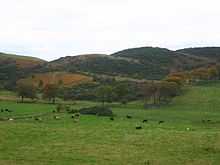Torphichen

Torphichen (/tɔrˈfɪxən/ tor-FIKH-ən)[1] is a small village located near Bathgate, West Lothian, Scotland. The placename may be Gaelic in origin, e.g., "Tóir Féichín" (the boundary/sanctuary of St Féichín), Tor Fithichean (Hill of the Ravens) or British, e.g., modern Welsh "tref fechan" (little town).
The village church is said to have been founded by St. Ninian in about 400CE, a small wooden structure on the site of the present church (itself rebuilt in 1756). The Knights Hospitaller of St. John made their Scottish headquarters at Torphichen from about 1160 and the Preceptory stands as testament to their presence.
Torphichen Parish "came out" in the Disruption of 1843 and the village has the oldest purpose-built Free Church, erected that same year, and now (since the reunification of the churches) the St. John's church hall.
The village clustered around the church and the village Square for centuries, slowly expanding northwards, a process accelerated by the creation of the James Wood Park in 1922 and of the building of council houses from 1945 in Greenside and Bowyett. In the mid-1950s, council housing was built in Priorscroft in the north and in St. John's Place in the south of the village. At that time, the village included a branch of Bathgate Co-op Society, a miners' welfare (reflecting locally resident miners rather than any substantial colliery) and a residents parish council.
In the early 1960s, the last council housing built in the village was erected in Northgate and Priorscroft in the north and also at Manse road in the south of the picturesque village.
The 1960s and 1970s saw an expansion of the village to the south with a scattering of substantial new private houses in Cathlaw Lane and Craigs Court. The 1990s saw building of more private homes at Priorsgrange and in the Loan but the village still has fewer than 350 dwellings.
Now, the commercial life of the village is focused on the post office/shop and the Torphichen Inn. A strong community life exists with an active church, SWRI, annual Children's Gala day and civic week, community centre and a range of other organisations. The Children's Gala day celebrated its Centenary in 2008 when Queen Caroline Perry was crowned by the First Minister of Scotland, Alex Salmond MSP.
Torphichen is part of the (UK) Falkirk East and Linlithgow Constituency (Michael Connarty, Labour); Scottish Linlithgow Constituency (Fiona Hyslop, Scottish National Party); and part of the Armadale and Blackridge Ward of West Lothian Council (Stuart Borrowman, Independent; Jim Dixon, Labour; and Isabel Hutton, Scottish National Party).

Knights Hospitaller
Torphichen Preceptory is a religious house founded by Knights Hospitaller at the invitation of King David I in the 1140s. The first mention of buildings in their use in the village dates from 1168. The last Preceptor of the House, Sir James Sandilands, surrendered the lands of the preceptory during the Reformation to the crown, but then bought them back as a private individual. He received the title Lord Torphichen.
Torphichen Hills Hillfort
Castlethorn, on the eastern side of the preceptory, is a scheduled prehistoric hillfort.
Torphichen and Bathgate Pipe Band
The Torphichen and Bathgate Pipe Band was established in 1902, and led the parade at the very first Gala Day in 1908. The band survived two World Wars and over the following decades won a host of championship prizes, including the Grade 2 World Championships in 1989. Today,the band is ranked amongst the world's best in the premier division of Grade 1 competition and features a roster of players drawn from all over Scotland.
References
- ↑ G.M. Miller, BBC Pronouncing Dictionary of British Names (London: Oxford UP, 1971), p. 149.
External links
Coordinates: 55°56′N 3°39′W / 55.933°N 3.650°W